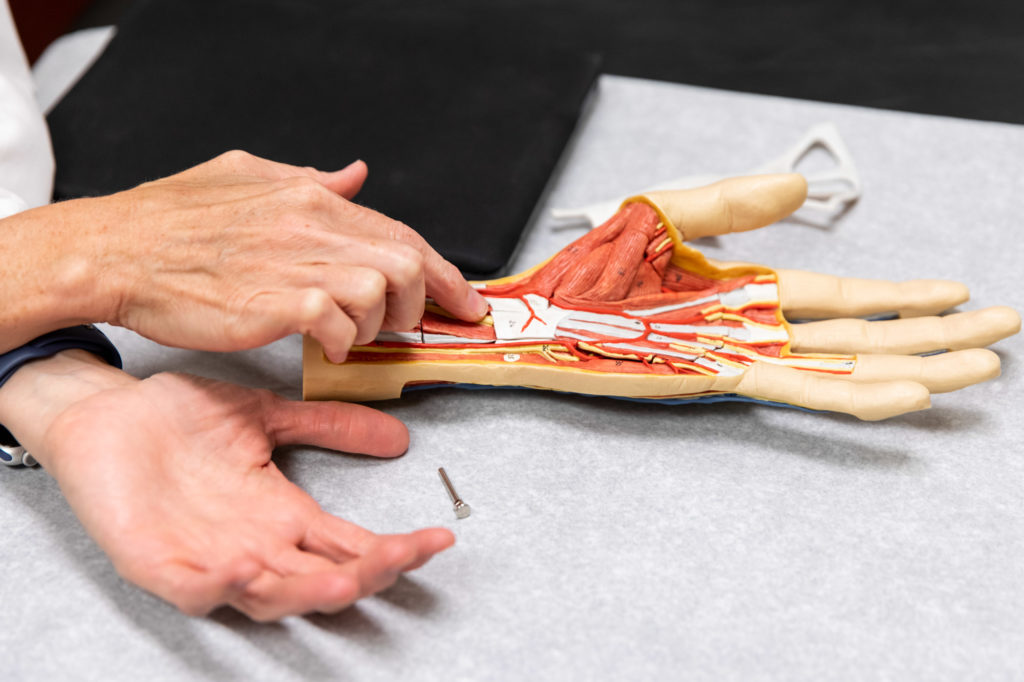

Know your bones
Are you over the age of 65? Are you a female? Have you broken a bone? Are you getting shorter? If you have answered yes to any of these questions, you may be at risk for Osteoporosis and may need to work on your bone health.
Osteoporosis is a silent disease because no one can feel their bones weakening. Usually the first sign of Osteoporosis is breaking a bone, getting shorter, or a curve of their upper spine. Osteoporosis means porous bone. Usually bone looks like honeycomb, but people with Osteoporosis have bigger holes in their honeycomb, which makes their bones less dense and easier to break if they fall.
Osteoporosis affects about 54 million Americans, with a male:female radio of 1:4. The most common osteoporotic fractures occur in the hip, spine, or wrist, but the ankle, shoulder and foot are likely as well.
There are many disease and medication risk factors that can contribute to Osteoporosis as shown in the table below. This list is not all inclusive.
| Diseases/conditions | Medications |
| Diabetes | Proton pump inhibitors (PPI) like Nexium, Prevacid, Prilosec |
| Hyperthyroidism/Hyperparathyroidism | SSRIs like Lexpro, Prozac, Zoloft |
| Premature menopause | Steroids like cortisone or prednisone |
| Rheumatoid arthritis, multiple sclerosis, lupus, ankylosing spondylitis | Antiseizure medications like Dilantin or phenobarbital |
| Weight loss surgery, celiac disease, Inflammatory bowel disease | Methotrexate |
| Stroke, Parkinson’s disease | Lithium |
| Breast or prostate cancer | Heparin |
| Leukemia, lymphoma, multiple myeloma, sickle cell disease | Cancer chemotherapy drugs |
| COPD, chronic kidney disease, HIV | Depo-Provera |
A DEXA scan (Dual Energy Xray Absorptiometry) is performed to determine the level of Osteoporosis.
Blood work is also done to check the level of vitamin D, calcium, blood cell counts, liver function, and PTH (parathyroid). These labs are performed wherever the patient normally gets their labs done.
Treatment is determined by multiple factors including number and type of fractures, T score from DEXA scan, FRAX calculation, and patient history. There are many different medications used to treat Osteoporosis in addition to diet and exercise. They fall into 2 different categories: antiresorptive or anabolic medications. Antiresorptive medications slow the breakdown of bone. Anabolic medications stimulate the rate of bone formation. Each medication has side effects though. Below is a table that summarizes the medications.
| Anti-resorptive | How it is administered | Side effects | Indicated for |
| Oral Bisphosphonates (Fosamax, Boniva, Actonel) | Daily or weekly oral pill | Increased GERD/acid reflux, gastric ulcers, Osteonecrosis of jaw (ONJ), atypical femur fractures | Men and women |
| Reclast (Zoledronic acid) | Once a year IV infusion | ONJ, Increased GERD/acid reflux, gastric ulcers, atypical femur fractures | Men and women |
| Prolia (Denosumab) | Injection into shoulder every 6 months | ONJ, Muscle and back pain, Increased risk of fracture when stopped, not used in patients with low blood calcium | Men and women |
| Evista (Raloxifene) | Daily oral pill | Leg cramps, hot flashes, not used in people with DVT or PE | Women |
| Calcitonin | Injection varies | Nausea, vomiting, flushing | Women |
| Anabolic | How it is administered | Side effects | Indicated for |
| Tymlos (Abaloparatide) | Daily injection into abdomen for 18months | Dizziness, headache, nausea, high urine calcium, fatigue, osteosarcoma (bone tumor)- seen in rats | Women |
| Forteo (Teriparatide) | Daily injection into abdomen for 24months | Dizziness, nausea, headache, high blood calcium, osteosarcoma (bone tumor)- seen in rats. Not used in patients with Paget’s disease | Men and women |
| Evenity (Romosozumab-aqqg) | Monthly injection into arm for 12 months | Cardiovascular events like stroke or heart attack, | Women |
In our office we mainly use Prolia, Tymlos or Evenity to treat Osteoporosis, but will discuss all options with our patients. Once someone has built their bones up by completing Tymlos or Evenity, we like to maintain the bone density with an antiresorptive medication like Prolia.
On top of any prescribed medication, we recommend all patients to take Calcium and vitamin D. Calcium and vitamin D is best from the food you eat, but can be taken as a supplement if unable to get the recommended amount in your diet. If taking a calcium supplement, only take 500mg at a time to ensure it will all be absorbed.
| Calcium | Vitamin D (men and women) | ||
| Women 50 and younger | 1000mg daily | 49 and younger | 400-800IU daily |
| Women 51 and older | 1200mg daily | 50 and older | 800-1000IU daily |
| Men 70 and younger | 1000mg daily | ||
| Men 71 and older | 1200mg daily | ||
Exercise is important for strong bones as well. Weightbearing exercises and muscle strengthening are the best way to increase bone density. Examples of weightbearing exercises include dancing, jogging, jumping rope, stair climbing, fast walking, elliptical machines, stair-step machines, low or high impact aerobics. Examples of muscle strengthening exercises include lifting weights, using exercise bands, or lifting your own body weight. Yoga has also been studied as a way to improve balance, flexibility and strength. Physical therapy can also help people learn which exercises are safe to do.
The goal of treatment is to reduce the risk of fractures, so if you haven’t fractured, then the medication is working. You may not feel any different after taking medications. You will only be able to determine if the medication is working after a repeat DEXA bone density scan. With antiresorptive medications, your bone density should stay the same or get better. With anabolic medications, your bone density should get better. There is not a specific amount the medications will increase your bone density. It will vary from person to person.
For more information you can go to www.nof.org/patients.


